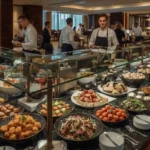Silver service, one of the most refined and traditional methods of food and beverage service, stands as a symbol of elegance, professionalism, and attention to detail. In the dynamic world of hospitality, understanding various service styles is vital, but mastering Silver Service elevates a professional’s ability to deliver top-tier guest experiences.
By reading this comprehensive guide, hotel management students, food and beverage professionals, and hospitality trainers will gain a clear understanding of Silver Service fundamentals, including its techniques, etiquette, table setup, service procedures, and modern-day applications, empowering them to perform confidently in formal dining settings and elevate guest experiences.
Understanding EPNS in Silver Service
What is EPNS?
EPNS (Electro Plated Nickel Silver) is a base metal alloy (usually a mix of copper, nickel, and zinc) that has been electroplated with a thin layer of pure silver. It is widely used in the hospitality industry, especially for cutlery, serving utensils, trays, and hollowware in Silver Service.
What is Silver Service?
Definition: Silver Service refers to a method of food service where food is served from a silver platter directly onto the guest’s plate using service gear such as a spoon and fork. The hallmark of Silver Service is finesse, grace, and formal presentation.
Origin and History: Silver Service traces its roots to the British aristocracy, particularly during the 18th and 19th centuries, when banquets and formal dinners required a sophisticated method of serving. Over time, this tradition was absorbed by the hospitality industry, becoming a standard in fine dining and luxury hotels worldwide.
Comparison with Other Service Styles:
- American Service: Food is plated in the kitchen and served from the right side.
- French Service: Involves tableside cooking and elaborate presentations.
- Russian Service: Entire dishes are presented and portioned at the sideboard.
- Silver Service: Combines elegance with efficient table service, focusing on serving from the left using service utensils.
For a clear and authoritative definition, refer to the “Silver service” Wikipedia page.
Key Features of Silver Service

Watch this quick video for a simple, visual explanation of silver service in fine dining’s most elegant serving style.
- Service from the Left: In Silver Service, food is traditionally served from the guest’s left side. This approach allows for a more graceful and controlled delivery, minimising disruptions to the guest’s experience.
- Use of Silverware: Service is performed using a specific set of utensils—typically a serving spoon and fork held in one hand like pincers. Mastery of this technique is essential and showcases the server’s skill and professionalism.
- Clockwise Service: Guests are generally served in a clockwise sequence around the table, beginning with the host’s guest of honour. This structured method ensures order and attention to social etiquette.
- Beverage Service from the Right: Unlike food, all beverages are served from the right-hand side. This aligns with standard etiquette and makes service smoother, especially when guests are right-handed, as is statistically common.
- Formal Table Setting: A Silver Service table is arranged with precision: charger plates, a range of cutlery specific to each course, multiple wine and water glasses, neatly folded linen napkins, and often elegant centrepiece arrangements.
- High Staff-to-Guest Ratio: This service style demands a high level of attention, often requiring a ratio of one server per guest or one for every two guests. This allows for exceptional attention to detail and highly personalised service.
Types of Silver Service
| Type | Description | Common Setting |
|---|---|---|
| Full Silver Service | The server presents food on silver platters and serves each guest individually using a service spoon and fork, typically from the left side. | Fine dining restaurants, state banquets |
| Modified Silver Service | Food is pre-plated in the kitchen, but the service follows Silver Service etiquette (served from the left, cleared from the right). | Banquet halls, hotel restaurants |
| English Service (Host Service) | The host or a senior guest at the head of the table serves food from platters to other guests, maintaining formality and tradition. | Private dining rooms, heritage hotels |
| Butler Service | The butler presents platters to guests, who serve themselves using the provided utensils. | Luxury private residences, VIP suites |
Roles and Responsibilities in Silver Service
- Head Waiter / Captain: Supervises service, handles VIP guests, ensures quality control.
- Waiter / Commis de Rang: Executes Silver Service, clears and resets tables, interacts with guests.
- Back Waiter / Busser: Assists in clearing, refilling water, and supporting service staff.
- Grooming & Etiquette: Impeccable hygiene, polished shoes, pressed uniform, and courteous behaviour are non-negotiable.
The success of Silver Service depends on well-trained staff. Discover the duties and responsibilities of waiters and waitresses to understand their crucial role in creating a seamless experience.
Table Setup and Equipment

Essential Equipment:
- Silver service spoon and fork
- Silver trays
- Napkins (linen preferred)
- Side plates, charger plates
- Cutlery for each course (starter, main, dessert)
- Wine and water glasses
Layout Tips:
- Ensure uniform spacing (approx. 24 inches per guest)
- Place cutlery in the order of use (outside to inside)
- Charger plates are used as a base until the main course is served
Mise en Place:
- All items are polished, counted, and checked prior to service
- Back station organised with hotplates, garnish bowls, and linen stock
For a deeper understanding, check out our guide on formal table settings that explains charger plates, utensils, and napkin folds.
Silver Service relies on pristine silverware and trays. The Britannica article on hollowware explores the craftsmanship behind these essential pieces, perfect for understanding their value and care in formal dining.
Gloves and Napkin Service Etiquette
Some 5-star properties use white gloves for certain courses or napkin-draped hands to:
- Avoid direct contact with plates.
- Prevent fingerprints on silverware.
- Elevate the perceived hygiene and professionalism.
Teach students when and how to use each method, and when gloves are discouraged (e.g., wine pouring).
Silver Service Procedure
Also known as “English Service” or “Service à l’Anglaise”
- Food Prepared and Plated on Service Platters: All food is fully cooked in the kitchen and neatly arranged on large silver or porcelain platters. Each dish is garnished and portioned for table-side serving by the waiter.
- Placing Platters on the Side Station or Sideboard: Platters and service dishes are placed on a sideboard near the guest’s table. Serving tools (typically a service spoon and fork) are prepared and aligned.
- Serving from the Left Side of the Guest: The waiter stands to the left of the guest and serves food using the service spoon and fork in one hand (typically the right hand). The service is done directly from the platter to the guest’s plate without the guest touching the food.
- Serving in Order and Sequence: Ladies are served first, followed by gentlemen, and the host last (unless specified otherwise). Courses are served individually, and one dish at a time is presented.
- No Table-Side Cooking: Unlike French service, no flambéing, carving, or cooking is done at the table. Food is only served, not finished or prepared in front of guests.
- Accompaniments Served Separately: Sauces, vegetables, or side dishes are served from separate platters or sauce boats. Each item is offered and served individually to maintain order and control.
- Clearing from the Right Side: Once guests finish eating, used plates and cutlery are cleared from the right side. The table is reset quietly and efficiently for the next course.
- High Skill and Elegance Required: Silver service demands excellent control and training, especially in one-handed serving techniques. It is usually performed by experienced staff in fine dining or formal banquet settings.
A systematic approach to serving guests enhances professionalism. Read more about the sequence of service in restaurants for a step-by-step guide on delivering excellent service.
Pros and Cons of Silver Service
Advantages:
- Highly professional and personalised
- Enhances guest satisfaction and brand image
- Ideal for showcasing culinary presentation
Disadvantages:
- Labor-intensive
- Higher costs due to staffing and equipment
- Requires extensive training and supervision
Training and Skills Required
Key Techniques:
- Balancing silver trays
- Using a spoon and fork service gear
- Silent service technique
Recommended Certifications:
- Diploma in Food and Beverage Service
- Advanced Service Techniques Workshops
- On-the-job training with mentors
Practical Tips:
- Practice tray service with water bowls
- Rehearse table setup and clearance drills
- Observe senior waitstaff during live service
Silver Service in Modern Hospitality
Though contemporary trends lean toward casual and fusion service, Silver Service still thrives in:
- Fine dining establishments like Michelin-starred restaurants
- Luxury hotel dining rooms (e.g., Ritz, Four Seasons)
- Cruise liners offering formal nights
- State banquets and VIP events
Modern Adaptations:
- Hybrid styles blending Silver Service with buffet elements
- Eco-conscious serving using reusable materials
- Tech-assisted services like digital menus and reservation systems
Sample Silver Service Menu
Appetizers:
- Smoked Salmon Rosette with Dill Cream
- Asparagus Spears with Hollandaise Sauce
Soup:
- Cream of Wild Mushroom with Truffle Oil
Main Course:
- Herb-Crusted Rack of Lamb with Red Wine Jus
- Grilled Sea Bass with Lemon Butter Sauce
- Vegetarian Option: Spinach and Ricotta Cannelloni
Accompaniments:
- Buttered New Potatoes
- Seasonal Vegetables
Dessert:
- Crème Brûlée
- Chocolate Fondant with Vanilla Ice Cream
Cheese Course:
- Selection of European Cheeses with Crackers and Grapes
Beverages:
- House White and Red Wines
- Sparkling Mineral Water
- Freshly Brewed Coffee and Herbal Teas
Conclusion
Mastering Silver Service is more than just learning a method; it’s about embracing a tradition of excellence, detail, and guest-centric care. For students and professionals in hospitality, gaining proficiency in this style not only enriches career potential but also builds confidence and class in high-pressure dining scenarios.
Whether you’re setting the table for royalty or serving a corporate gala dinner, the skills outlined in this guide will ensure you uphold the gold standard in food and beverage service.
FAQs
Q1: What is the biggest challenge in learning Silver Service?
Handling service gear with grace and consistency under pressure.
Q2: Is Silver Service still relevant today?
Yes, especially in luxury hospitality settings and formal events.
Q3: Can Silver Service be combined with buffet service?
Yes, hybrid service models are increasingly used in banquets and weddings.
Related Articles You May Like:
- Gueridon Service: A Complete Guide to Tableside Excellence
- What Are the Types of Food and Beverage Service in the Hospitality Industry?
- What Is Mise en Place? A Complete Guide for F&B Operations
- Food & Beverage Service SOPs for Restaurant, IRD & Banquet
- Types of Trolleys Used in Gueridon Service
Subscribe and join our community of hospitality professionals & students — get insights, tips, and the latest updates delivered straight to your inbox!







